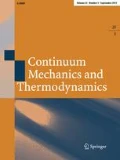Abstract
Elastic structural members are considered with plastic hinges at which damage may occur. Equations of balance of linear momentum, angular momentum and energy are obtained expressing the fact that energy may be absorbed by damage at a plastic hinge. It is shown that all the work done by the moments in bending of a plastic hinge that does not appear as heat must be absorbed by damage. The fraction of the bending work which is transformed into damage is thecoefficient of damage. In general, this coefficient is smaller than unity, which implies that the plastic hinge is a heat source. The heat source manifests itself by producing a jump discontinuity in axial heat flux and thus, in virtue of Fourier's law, a jump discontinuity in temperature gradient ensues. The general thermodynamics of the system is formulated: It is shown that agreement with the second law of thermodynamics prevails if the coefficient of damage does not exceed unity. Using the condition that a plastic hinge must break after absorbing a critical amount of damage energy, we show that a structure composed of such structural members with a finite number of plastic hinges must fail before it absorbs an infinite amount of energy through a cyclic loading and unloading program. Although the failure criterion for a single plastic hinge may be simple, the complex distribution of damage among the plastic hinges of an entire structure can make the failure criteria for a structure defy simple rules. It is also argued that the introduction of a distributed damage energy rate does not seem feasible in view of the second law of thermodynamics. This suggests that damage in a microstructure is localized rather than uniformly distributed.
Similar content being viewed by others
References
Erber, T.; Guralnick, S. A.; Latal, H. G.: A general phenomenology of hysteresis. Ann. Phys. 69 (1972) 161–192
Guralnick, S. A.: Incremental collapse under conditions of partial unloading. Publications, International Association for Bridge and Structural Engineering, Zurich Switzerland 33 (1973) 64–84
Guralnick, S. A.: An incremental collapse model for metal fatigue. Publications, International Association for Bridge and Structural Engineering, Zurich Switzerland 35 (1975) 83–99
Guralnick, S. A.; Singh, S.; Erber, T.: Plastic collapse, shakedown and hysteresis. J. Struct. Engng. ASCE 110 (1984) 2103–2119
Guralnick, S. A. et al.: Plastic collapse, shakedown and hysteresis of multi-story steel structures. J. Struct. Engng. ASCE 112 (1986) 2610–2627
Guralnick, S. A.; Erber, T.; Soudan, O.; Stefanis, J.: Energy method for incremental collapse analysis of framed structures. J. Struct. Engng. ASCE 114 (1988) 31–49
Erber, T.; Guralnick, S. A.: Hysteresis and incremental collapse: The iterative evolution of a complex system. Ann. Phys. 181 (1988) 25–53
Timoshenko, S.: Strength of Materials. Part I, 2nd ed., D. Van Nostrand Co., N.Y. (1940)
Halford, G. R.: Ph. D. Thesis Department of Theoretical and Applied Mechanics, University of Illinois (1966)
Weinstock, H.; Erber, T.: Threshold of Barkhausen Emission and the onset of hysteresis in iron. Physical Review B 31 (1985) 1535–1553
Author information
Authors and Affiliations
Rights and permissions
About this article
Cite this article
Bernstein, B., Erber, T. & Guralnick, S.A. Thermodynamics of plastic hinges with damage. Continuum Mech. Thermodyn 3, 293–309 (1991). https://doi.org/10.1007/BF01126412
Received:
Issue Date:
DOI: https://doi.org/10.1007/BF01126412




